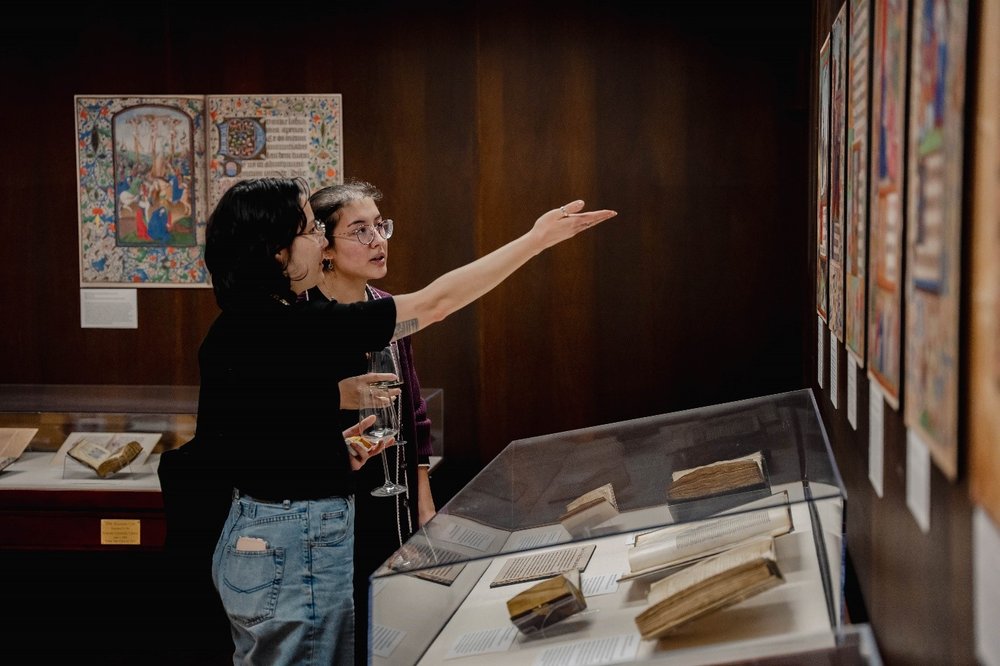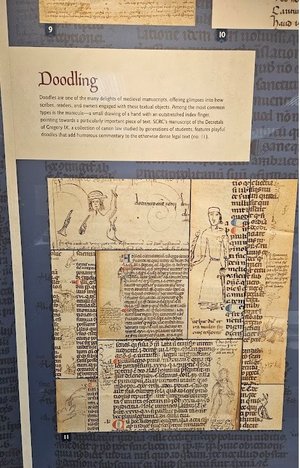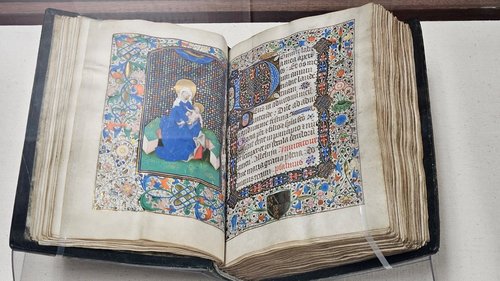Students in LIT 245: Florence and the Renaissance World reflect on SCRC’s exhibit

Visitors touring the exhibition during the reception.
Students from Dr. Lauren Surovi’s class, LIT 245: Florence & the Renaissance World, visited the Special Collections Research Center on the 6th floor of Bird Library in February 2025 and toured this semester’s exhibition, The Making of the Medieval Book, with Dr. Irina Savinetskaya, SCRC Early to Pre-20th Century Curator.
The Making of the Medieval Book (January 27-August 15, 2025) on the sixth floor of Bird Library explores how medieval books were made, used and re-used over time, as well as their impact on early printed books and modern book design. The exhibition showcases SCRC’s collection of predominantly Western European medieval manuscripts made between the 13th and 16th centuries, alongside printed and handwritten materials from the Byzantine Empire, Ethiopia, Persia, and Japan. Also featured are examples of eighteenth- to twentieth-century bookmaking from both sides of the Atlantic that drew inspiration from the medieval book.
Students in Dr. Surovi’s class shared the excerpted reflections below following their visit:

Reproductions of doodles found in the Decretals of Gregory IX, Bologna, circa 1300. MS 1, Rare Book and Printed Materials Collection, SCRC.
- “What I found most interesting was the drawings and doodles in the margins of the writings... because it was able to humanize and make the exhibit more personable…I thought it was really cool that there were notes, pointing fingers, and doodles written and drawn by the students to further understand what they were learning...”

Le Louchier or Syracuse Hours, Tournai or Ghent, circa 1475. MS 2, Rare Book and Printed Materials Collection, SCRC.
- “The Book of Hours with a hard-shelled back cover caught my eye… I found the book's cover to be quite compelling, as it shows artistic images that are incredibly detailed… The Book of Hours is an artistic and religious treasure.”
- “The Book of Hours, Tournai or Ghent (circa 1475)…I learned that these books were completely customizable, and could include any Saints the family wanted to have… families would use their Book of Hours as a sort of record of births and deaths as well… [it] connects to broader themes of our course like the dissemination of knowledge or the cultural history during the Italian medieval periods…”
- “One item that really fascinated me was the manuscript for a law school in Bologna, which was very well known in the late thirteenth to fourteenth century. I learned that students were required to read these texts, and they often annotated and wrote on the pages as a way to engage with the material. The description noted that these manuscripts were sometimes passed down from student to student, allowing for sharing of notes and scholarly discourse across generations. This shows the collaborative nature of medieval education… This reminded me of our class discussions on educational texts, particularly how Machiavelli’s writings were designed to instruct and shape future leaders and thinkers.”

Fragment from a Jewish prayer book, France?, circa 1250-1300. Manuscript Waste Fragments Collection, SCRC
- “One of the items that I further looked into was the fragment from a Jewish prayer book in France from around the 1250-1300 time. While scanning the various items in the glass boxes, the Hebrew writing on the leaf almost immediately caught my eye and interested me in taking a deeper read regarding its potential origin. When looking at the Hebrew text, I was even able to make out some of the words despite the absence of vowels (which is expected)… The leaf had supposedly come from a Mahozor, a festival prayer book read on the high Jewish holidays. What also struck me was the fact that the origin of this page in a Mahozor was produced prior to the 1306 expulsion of the Jewish community in France. No matter what the context may be of where/how the text was found, it resembles a symbol of strength and resilience in my mind by the Jewish people.”
- “Dr. Savinetskaya explaining how a book planner would plan out each page and its ornaments, where images would be drawn and what type of graphic would be displayed. Then it would be the job of the artist to apply these colors and drawings to the description provided by the planner. Every step of the book was planned by one person and executed by another.”
- “Reflecting on this, I see parallels to how college students today engage with their own academic texts. Just as medieval students interacted with their books by writing in the margins, today’s students highlight key passages, add notes, and even collaborate through digital platforms to share insights. The tradition of building upon past knowledge continues, even as the medium has changed from parchment manuscripts to printed textbooks and online resources…This historical perspective highlights how educational materials have evolved while maintaining the same fundamental purpose: to instruct, inspire, and connect generations of learners.”
